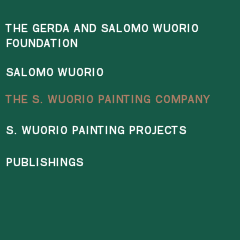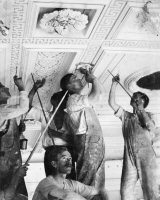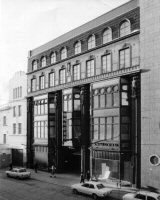
  |
THE S. WUORIO PAINTING COMPANYSalomo Wuorio opened his own painting company in Helsinki in January 1890, while the painting work at the National Archives was still ongoing. Salomo Wuorio quickly gained the trust of his customers. Already in the 1890's, the S. Wuorio Painting Company was commissioned with the painting work of the most important new buildings in the city, but they also worked elsewhere in Finland. The painting contract for the National Arhives was Wuorio's first major work in Helsinki, and success in carrying it out undoubtedly helped in getting the contract for the House of the Estates. Carrying out the decorative painting on these two monumental buildings gave Wuorio such a reputation that every self-respecting resident of Helsinki wanted their house to be painted specifically by his company. The activities develop During the 1890's, the S. Wuorio painting company became the leading painting business in Helsinki and in the whole of Finland. At the time of start-up, the company's workshop and office both fitted in an outhouse at Vuorikatu 5. After a couple of years, the company moved to Pohjoisesplanadi 7 where the Wuorio family also lived. The S. Wuorio Wallpaper and Carpet Shop was opened in the same building in March 1900. The decorative painting and plate studios, which had grown extensively, were relocated to Aleksanterinkatu 13, i.e. the Lundqvist business palace. The shop space at Pohjoisesplanadi soon began to become cramped and in 1901 the wallpaper and carpet shop and the painting company's office moved to Aleksanterinkatu 9. The golden age of decorative painting comes to an end Salomo Wuorio was able to anticipate the new trends and farsightedly widened his company's field of activity to be able to respond to the changed demand. Especially lead glazing became enormously popular. They were a perfect response to the demand for carefully designed details and they invoked creative enthusiasm among artists and architects. Many stained glass works designed by persons at the forefront of Finnish artistic life were painted at the Wuorio studio, like in 1902 the lead glass work designed for the foyer of the Finnish National Theatre by architect Eliel Saarinen. The Wuorio business palace The painting company after Salomo Wuorio The company, led by Gunnar Wuorio, was divided into two partnership firms on January 1, 1949. The painting department retained its name as S. Wuorio Painting Company, but the name of the carpet and wallpaper department was changed to G. Wuorio & co. In 1963 the companies were changed into limited companies. In 1965, the three leading figures and principal shareholders of the companies, Ilmari Tähtinen, Nils Långhjelm and Gunnar Wuorio, died. Master painter Ilmari Fall became the managing director of the S. Wuorio Painting Company. Ilmari Fall retired in 1973. After this, master painter Sulo Tapaninen acted as the managing director of the painting company until 1979. In 1979, the S. Wuorio Painting Company operated in the premises at Unioninkatu 10 and Carpet House Wuorio at Unioninkatu 30. Master painter Pertti Hukkanen came to the workshop to buy 17 carat leaf gold, which could not be found anywhere else in Helsinki. He found suitable leaf gold, but in tandem he was offered the whole company. Accordingly, Hukkanen bought the S. Wuorio Painting Company Ltd., including its stock and archival material. The S. Wuorio Painting Company Ltd does not operate any more. |